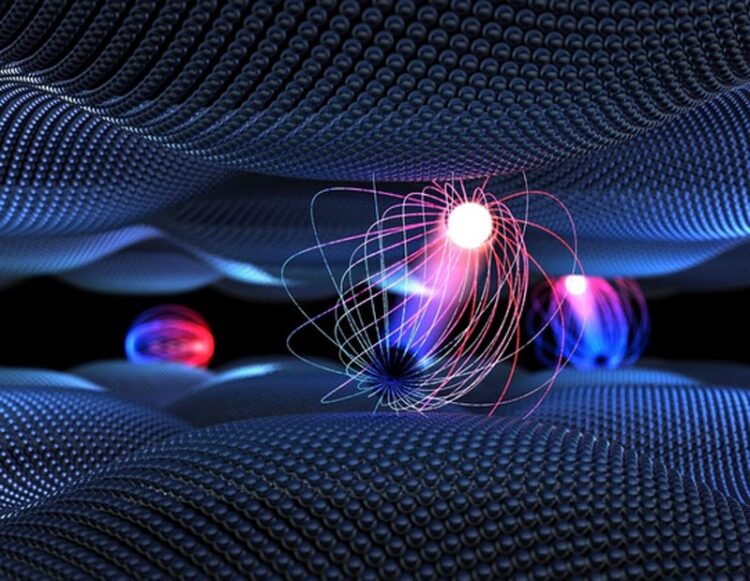Building blocks of the future for photovoltaics

Artistic representation showing the twisted layers of tungsten diselenide (top) and molybdenum disulphide (bottom). Following excitation using light, a multitude of optically “dark” excitons form between the layers. These “dark” excitons are electron-hole pairs bound by Coulomb interaction (light and dark spheres connected by field lines), which cannot be directly observed using visible light. One of the most interesting quasiparticles is the "moiré interlayer exciton" – shown in the middle of the image - in which the hole is located in one layer and the electron in the other. The formation of these excitons on the femtosecond time scale and the influence of the Moiré potential (illustrated by peaks and troughs in the layers) were investigated in the current study using femtosecond photoemission momentum microscopy and quantum mechanical theory.
Credit: Brad Baxley, Part to Whole, LLC
Research team led by Göttingen University observes formation of “dark” moiré interlayer excitons for the first time.
An international research team led by the University of Göttingen has, for the first time, observed the build-up of a physical phenomenon that plays a role in the conversion of sunlight into electrical energy in 2D materials. The scientists succeeded in making quasiparticles – known as dark Moiré interlayer excitons – visible and explaining their formation using quantum mechanics. The researchers show how an experimental technique newly developed in Göttingen, femtosecond photoemission momentum microscopy, provides profound insights at a microscopic level, which will be relevant to the development of future technology. The results were published in Nature.
Atomically thin structures made of two-dimensional semiconductor materials are promising candidates for future components in electronics, optoelectronics and photovoltaics. Interestingly, the properties of these semiconductors can be controlled in an unusual way: like Lego bricks, the atomically thin layers can be stacked on top of each other. However, there is another important trick: while Lego bricks can only be stacked on top – whether directly or twisted at an angle of 90 degrees – the angle of rotation in the structure of the semiconductors can be varied. It is precisely this angle of rotation that is interesting for the production of new types of solar cells. However, although changing this angle can reveal breakthroughs for new technologies, it also leads to experimental challenges.
In fact, typical experimental approaches have only indirect access to the moiré interlayer excitons, therefore, these excitons are commonly termed “dark” excitons. “With the help of femtosecond photoemission momentum microscopy, we actually managed to make these dark excitons visible,” explains Dr. Marcel Reutzel, junior research group leader at the Faculty of Physics at Göttingen University. “This allows us to measure how the excitons are formed at a time scale of a millionth of a millionth of a millisecond. We can describe the dynamics of the formation of these excitons using quantum mechanical theory developed by Professor Ermin Malic’s research group at Marburg.”
“These results not only give us a fundamental insight into the formation of dark Moiré interlayer excitons, but also open up a completely new perspective to enable scientists to study the optoelectronic properties of new and fascinating materials,” says Professor Stefan Mathias, head of the study at Göttingen University’s Faculty of Physics. “This experiment is ground-breaking because, for the first time, we have detected the signature of the Moiré potential imprinted on the exciton, that is, the impact of the combined properties of the two twisted semiconductor layers. In the future, we will study this specific effect further to learn more about the properties of the resulting materials.”
This research was made possible thanks to the German Research Foundation (DFG) who provided Collaborative Research Centre funding for the CRCs “Control of Energy Conversion on Atomic Scales” and “Mathematics of Experiment” in Göttingen, and the CRC “Structure and Dynamics of Internal Interfaces” in Marburg.
Original publication: Schmitt et al. “Formation of moiré interlayer excitons in space and time”, Nature 2022. DOI: 10.1038/s41586-022-04977-7
Contact:
Professor Stefan Mathias
University of Göttingen
Faculty of Physics – I. Physical Institute
Friedrich Hund Weg 1, 37077 Göttingen, Germany
Tel: +49 (0)551 39-27601
Email: smathias@uni-goettingen.de
https://www.uni-goettingen.de/en/580823.html
Journal: Nature
DOI: 10.1038/s41586-022-04977-7
Method of Research: Experimental study
Subject of Research: Not applicable
Article Title: Formation of moiré interlayer excitons in space and time
Article Publication Date: 17-Aug-2022
Media Contact
Melissa Sollich
University of Göttingen
melissa.sollich@uni-goettingen.de
Office: 49-551-392-6228
Original Source
All latest news from the category: Physics and Astronomy
This area deals with the fundamental laws and building blocks of nature and how they interact, the properties and the behavior of matter, and research into space and time and their structures.
innovations-report provides in-depth reports and articles on subjects such as astrophysics, laser technologies, nuclear, quantum, particle and solid-state physics, nanotechnologies, planetary research and findings (Mars, Venus) and developments related to the Hubble Telescope.
Newest articles

Superradiant atoms could push the boundaries of how precisely time can be measured
Superradiant atoms can help us measure time more precisely than ever. In a new study, researchers from the University of Copenhagen present a new method for measuring the time interval,…

Ion thermoelectric conversion devices for near room temperature
The electrode sheet of the thermoelectric device consists of ionic hydrogel, which is sandwiched between the electrodes to form, and the Prussian blue on the electrode undergoes a redox reaction…

Zap Energy achieves 37-million-degree temperatures in a compact device
New publication reports record electron temperatures for a small-scale, sheared-flow-stabilized Z-pinch fusion device. In the nine decades since humans first produced fusion reactions, only a few fusion technologies have demonstrated…





















